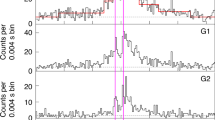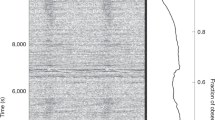Abstract
The energy source of the anomalous X-ray pulsars1 (AXPs) is not understood, hence their designation as anomalous. Unlike binary X-ray pulsars, no companions are seen, so the energy cannot be supplied by accretion of matter from a companion star. The loss of rotational energy, which powers radio pulsars, is insufficient to power AXPs. Two models are generally considered: accretion from a large disk left over from the birth process2,3, or decay of a very strong magnetic field (1015 G) associated with a ‘magnetar’4. The lack of counterparts at other wavelengths has hampered progress in our understanding of these objects. Here we report deep optical observations of the field around 4U0142+61, which is the brightest AXP in X-rays. The source has no associated supernova remnant, which, together with its spin-down timescale of ∼105 yr (ref. 5), suggests that it may be relatively old. We find an object with peculiar optical colours at the position of the X-ray source, and argue that it is the optical counterpart. The optical emission is too faint to admit the presence of a large accretion disk, but may be consistent with magnetospheric emission from a magnetar.
This is a preview of subscription content, access via your institution
Access options
Subscribe to this journal
Receive 51 print issues and online access
$199.00 per year
only $3.90 per issue
Buy this article
- Purchase on Springer Link
- Instant access to full article PDF
Prices may be subject to local taxes which are calculated during checkout



Similar content being viewed by others
References
Mereghetti, S. in Proc. NATO ASI School “The Neutron Star—Black Hole Connection” (eds Kouveliotou, C., van Paradijs, J. & Ventura, J.) (Kluwer Academic Publishers, Dordrecht, 1999); also preprint astro-ph/9911252 at 〈xxx.lanl.gov〉 (1999).
Marsden, D., Lingenfelter, R. E., Rothschild, R. E. & Higdon, J. C. Nature vs. nurture: The origin of soft gamma-ray repeaters and anomalous X-ray pulsars. Astrophys. J. (submitted); also preprint astro-ph/9912207 at 〈xxx.lanl.gov〉 (1999).
Chatterjee, P., Hernquist, L. & Narayan, R. An accretion model for anomalous X-ray pulsars. Astrophys. J. 534, 373–379 (2000).
Thompson, C. & Duncan, R. C. The soft gamma repeaters as very strongly magnetized neutron stars. II. Quiescent neutrino, X-ray, and alfven wave emission. Astrophys. J. 473, 322– 342 (1996).
Wilson, C. A., Dieters, S., Finger, M. H., Scott, D. M. & van Paradijs, J. Rossi X-ray timing explorer observations of the anomalous pulsar 4U0142+61. Astrophys. J. 513, 464–470 (1999).
Oke, J. B. et al. The Keck low-resolution imaging spectrometer. Publ. Astron. Soc. Pacif. 107, 375–385 (1995).
Phelps, R. L. & Janes, K. A. Young open clusters as probes of the star formation process. 1: An atlas of open cluster photometry. Astrophys. J. 90, 31–82 (1994).
Fukugita, M., Shimasaku, K. & Ichikawa, T. Galaxy colors in various photometric band systems. Publ. Astron. Soc. Pacif. 107, 945– 958 (1995).
Cardelli, J. A., Clayton, G. C. & Mathis, J. S. The relationship between infrared, optical, and ultraviolet extinction. Astrophys. J. 345, 245– 256 (1989).
White, N. E., Angelini, L., Ebisawa, K., Tanaka, Y. & Ghosh, P. The spectrum of the 8.7s X-ray pulsar 4U0142+61. Astrophys. J. 463, L83– L86 (1996).
Predehl, P. & Schmitt, J. H. M. M. X-raying the interstellar medium: ROSAT observations of dust scattering halos. Astron. Astrophys. 293, 889–905 ( 1995).
Perna, R., Hernquist, L. & Narayan, R. Emission spectra of fall back disks around young neutron stars. Astrophys. J. 541, 344– 350 (2000).
Vrtilek, S D. et al. Observations of Cygnus X-2 with IUE–Ultraviolet results from a multiwavelength campaign. Astron. Astrophys. 235, 162–173 (1990).
Hulleman, F., van Kerkwijk, M. H., Verbunt, F. W. M. & Kulkarni, S. R. A deep search for the optical counterpart to the anomalous X-ray pulsar 1E 2259+58.6. Astron. Astrophys. 358, 605– 611 (2000).
Mereghetti, S. & Stella, L. The very low mass X-ray binary pulsars: A new class of sources? Astrophys. J. 422, L17–L20 (1995).
Stella, L., White, N. E. & Priedhorsky, W. The discovery of a 685 second orbital period from the X-ray source 4U 182030 in the globular cluster NGC 6624. Astrophys. J. 312, L17–L21 ( 1987).
Paczynski, B. X-ray pulsar 1E 2259+586—A merged white dwarf with a 7 second rotation period? Astrophys. J. 365, L9– L12 (1990).
Ferrario, L., Vennes, S., Wickramasinghe, D. T., Bailey, J. A. & Christian, D. J. EUVE J0317-855 A rapidly rotating, high-field magnetic white dwarf. Mon. Not. R. Astron. Soc. 292, 205–217 (1997).
Pivovaroff, M. J., Kaspi, V. M. & Camilo, F. X-ray observations of the high magnetic field radio pulsar PSR J1814-1744. Astrophys. J. 535, 379–384 (2000).
Bessell, M. S. in Proc. IAU Coll. 136, Stellar Photometry—Current Techniques and Future Developments (eds Butler, C. J. & Elliott, I.) 22– 39 (Cambridge Univ. Press, Cambridge, 1992).
Schlegel, D. J., Finkbeiner, D. P. & Davies, M. Maps of dust infrared emission for use in estimation of reddening and cosmic microwave background radiation foregrounds. Astrophys. J. 500, 525–553 (1998).
White, N. E. et al. A 25 min modulation from the vicinity of the unusually soft X-ray source X0142+614. Mon. Not. R. Astron. Soc. 226 , 645–654 (1987).
Motch, C. et al. A ROSAT glance at the galactic plane. Astron. Astrophys. 246, L24–L27 ( 1991).
Van den Berg, M. & Verbunt, F. Spectroscopic confirmation of the optical identification of X-ray sources used to determine accurate positions for the anomalous X-ray pulsars 1E 2259+58.6 and 4U 0142+61. Astron. Astrophys. (submitted).
Monet, D. et al. USNO-A V2.0, A Catalog of Astrometric Standards (US Naval Observatory Flagstaff Station (USNOFS) and Universities Space Research Association (USRA) stationed at USNOFS, 2000).
Baraffe, I., Chabrier, G., Allard, F. & Hauschildt, P. H. Evolutionary models for solar metallicity low-mass stars: mass-magnitude relationships and color-magnitude diagrams. Astron. Astrophys. 337 , 403–412 (1998).
Bergeron, P., Wesemael, F. & Beauchamp, A. Photometric calibration of hydrogen- and helium-rich white dwarf models. Publ. Astron. Soc. Pacif. 107, 1047–1054 (1995).
Stetson, P. B. DAOPHOT—A computer program for crowded-field stellar photometry. Publ. Astron. Soc. Pacif. 99, 191– 222 (1987).
Stetson, P. B. Homogeneous photometry for star clusters and resolved galaxies. II. Photometric standard stars. Publ. Astron. Soc. Pacif. 112, 925–931 (2000).
Acknowledgements
We thank D. Kaplan for undertaking the observations at the 60-inch telescope, and acknowledge helpful discussions with B. Paul and F. Verbunt. Model atmospheres for hot white dwarfs were kindly provided by J. Heise. The observations were obtained at the W. M. Keck Observatory on Mauna Kea, Hawaii, which is operated by the California Association for Research in Astronomy. This research made use of the SIMBAD data base. M.H.v.K. is supported by the Royal Netherlands Academy of Science (KNAW). S.R.K.'s research is supported, in part, by grants from the National Science Foundation and the National Aeronautics and Space Administration.
Author information
Authors and Affiliations
Corresponding author
Rights and permissions
About this article
Cite this article
Hulleman, F., van Kerkwijk, M. & Kulkarni, S. An optical counterpart to the anomalous X-ray pulsar 4U0142+61. Nature 408, 689–692 (2000). https://doi.org/10.1038/35047024
Received:
Accepted:
Issue Date:
DOI: https://doi.org/10.1038/35047024
This article is cited by
-
The Galway astronomical Stokes polarimeter: an all-Stokes optical polarimeter with ultra-high time resolution
Experimental Astronomy (2013)
-
The strongest cosmic magnets: soft gamma-ray repeaters and anomalous X-ray pulsars
The Astronomy and Astrophysics Review (2008)
-
Anomalous X-ray pulsars: persistent states with fallback disks
Astrophysics and Space Science (2007)
-
Our distorted view of magnetars: application of the resonant cyclotron scattering model
Astrophysics and Space Science (2007)
-
QED can explain the non-thermal emission from SGRs and AXPs: variability
Astrophysics and Space Science (2007)
Comments
By submitting a comment you agree to abide by our Terms and Community Guidelines. If you find something abusive or that does not comply with our terms or guidelines please flag it as inappropriate.



